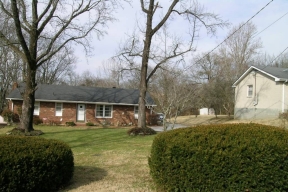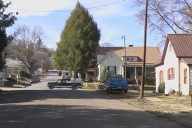Suburban Areas
Suburban areas are lower density areas that separate residential and commercial areas from one another. They are either part of a city or urban area, or exist as a separate residential community within commuting distance of a city. As cars became the dominant way for people to get to work, suburbs grew. Tennessee is rich in suburban communities, each with their own successes and struggles at mixing development and health.

What is different about suburban health?
What is sprawl?
How can suburban areas encourage physical activity?
Who does planning in my area?
What about economic development?
Why conserve suburban green space?
Why is zoning important to health?
Why is multimodal transportation important?
Government partners
Additional resources
What is different about suburban health?
In general terms, suburban communities tend to be the most affluent, enjoying the highest socioeconomic status when ranked with rural and urban populations. Suburban communities often have more job opportunities then rural areas though maybe not as many as urban areas. Overall, suburban residents seem to have better health than rural or inner city residents. People living in suburban communities tend to be more educated. Suburban residents are the most likely to have adequate health insurance and benefit from longer life expectancy, more access to health care and higher quality of care.
People living in suburban areas often benefit from access to and choices for nutritious food, spaces for physical activity and recreation, utilities such as water and sewer, health and dental care, transportation and even digital telecommunications.
The U.S. Census separates urban and rural in their statistics, though what is urban and suburban is not specified. There is no statistical definition of suburban. It’s more of how a place feels connected to a big city and the general land use pattern. Some suburban areas will feel quite urban while other suburban areas may seem rural. Some planners would suggest asking the residents if their neighborhood was suburban, urban or rural and going with what most people felt.
The Tennessee Department of Health is committed to improving the health and well-being of all our residents. We understand health is influenced by place because of the environmental and cultural characteristics of neighborhoods and communities. For many people the suburbs are a great place to call home and raise a family. While the suburbs can be a great place to be, not everything is perfect. One important on-going discussion for suburban committees is sprawl.
What is a sprawl?

Sprawl is pattern of development. Many planners consider sprawl to be low quality growth and expansion. Sprawl is often described by four factors:
- low development density,
- separated homes, shops and workplaces,
- lack of activity centers and downtowns, and
- poor street connectivity.
According to Smart Growth America, individuals in compact, connected areas have greater economic mobility. People in these areas spend less on the combined cost of housing and transportation. People in compact, connected areas tend to live longer, safer, healthier lives than their peers in areas with sprawl. Sprawl has been linked to:
- reduced physical activity,
- reduced air quality,
- reduced social interaction,
- increased obesity,
- increased risk of traffic fatalities,
- increased emergency response times, and
- increased commute distances, times and costs.
How can suburban areas encourage physical activity?
Residents of suburban communities often enjoy greater access to opportunities for healthy food stores and active lifestyles facilities such as fitness centers. Suburban areas often enjoy a variety of opportunities for physical activity available like:
- playgrounds and sports fields,
- sidewalks and bikeways,
- greenways and trails,
- public swimming pools and lakes,
- nature parks and pet parks, plus
- walking, biking and bus riding to school.
Who does planning in my area?
Areas of 50,000 or greater population maintain a continuing, comprehensive and cooperative transportation planning process. Metropolitan Planning Organizations (MPO) and Transportation Planning Organizations (TPO) administer federal funding and provide technical expertise for transportation projects. Tennessee's 11 MPOs and TPOs serve Bristol, Chattanooga, Clarksville, Cleveland, Jackson, Johnson City, Kingsport, Knoxville, Lakeway, Memphis and Nashville.
Tennessee has 9 Development Districts of municipal and county governments working together on planning and development. Development Districts bring elected leaders from cities and counties together with leaders from other community organizations to address regional issues and to promote economic development.
What about economic development?
The Department of Economic and Community Development has several programs supporting quality of life improvements in communities such as Community Development Block Grant, Tennessee Main Street and ThreeStar. ECD funds initiatives to connect communities to advance economic development through funding and technical assistance. ECD has programs to support existing large industries and small businesses and to attract new industries and businesses. ECD promotes Tennessee as a great place to make a living because at the heart of a competitive economic development strategy is community development.
Why conserve suburban green space?
Many suburban communities in Tennessee are growing quickly. Even though there may appear to be a lot of green space left for expansion, environmental changes frequently occur and cause problems for these communities. Rapid loss of lands due to uncontrolled growth can undermine property values. Sprawling development can ruin important natural areas such as wetlands, prairies and forests. Conservation of lands protects the air, land and water from environmental pollution which is harmful to health. Green spaces such as wildlife refuges and state forests protect plants and animals. Conservation areas protect the scenic views which attract tourists, along with the jobs and economic opportunities created through spaces hiking, hunting, fishing, bird watching and nature observation.
There are several options for preserving green space. Conservation development is controlled-growth land use that protects the area's natural environment in perpetuity by preserving landscapes, sustaining farmland, protecting natural habitats for wildlife and maintaining the character of rural communities. Land trusts are voluntary conservation easements. Land trusts safeguard the land from development and sprawl. Families who have passed down the same property from generation to generation often like entering into a land trust to know their family home will remain similar to how they remember it. In addition to improved property values, many people feel their quality of life is improved when there is protected green space nearby.
Why are zoning policies important to health?
Zoning is a land use planning tool. Zoning has been used in urban, suburban and rural settings. Zoning means what can go where. What goes where can have a major impact on health. Zoning policy can influence neighborhood factors that lead to health outcomes such as physical activity, violent crime and obesity. Zoning can be used to restrict or prohibit certain land uses in certain areas. Zoning can help to slow sprawl. Zoning can encourage certain land uses. For example, mixed use zoning can increase density connecting people and places leading to more active transportation and physical activity. Zoning policies can encourage or require healthier options such as sidewalks, bike lanes, affordable housing or green spaces. Effective zoning policies can increase property values and decrease health inequities.
Why is multimodal transportation?
Multimodal transportation supports the needs of all users whether they choose to walk, bike, use public transit or drive. It means more transportation options and more freedom in how people get around. For example, the use of sidewalks, bike lanes, pedestrian crossings, bus routes and other transportation options to increase connectivity of places. These transportation options can be designed to be safer for all people, especially children, older adults and those with disabilities. According the Tennessee Department of Transportation (TDOT), good walking, biking and transit facilities are essential to the continued growth and success of our towns and cities. In fact, both the millennial and baby boomer generations are looking for transportation options in the places where they live.
Government partners
Tennessee Department of Commerce and Insurance (E&CD)
E&CD Website
www.tn.gov/ecd.html
Tennessee Department of Transportation (TDOT)
TDOT Website
www.tn.gov/tdot.html
U.S. Environmental Protection Agency (EPA)
Smart Growth Resources
www.epa.gov/smartgrowth
Additional resources
The Land Trust for Tennessee
landtrusttn.org
Tennessee Recreation and Parks Association
Benefits of Parks and Recreation
www.trpa.net
Smart Growth America
Measuring Sprawl 2014
www.smartgrowthamerica.org/measuring-sprawl
WeGo Public Transit
Relax and Ride
rtarelaxandride.com
Helpful documents
Tennessee Department of Health & Nashville Civic Design Center
Suburban Transect Infosheet
PDF